#southern York County PA
Text

Lilacs in October
#lilacs in October#October blooms#october blooming#second blooming#lilac second blooming#pennsylvania#southeastern PA#southern York County PA#York County PA#lilacs in bloom#brilliant blue skies#October skies#October blue sky
4 notes
·
View notes
Text
CFB Promotion and Relegation - The Big East
Big East Tier One - The Big East (FBS):
Louisville
Cincinnati
West Virginia
Penn State
Pittsburgh
Syracuse
Rutgers
Boston College
Connecticut
Big East Tier Two - Conference USA (FBS):
Marshall
Temple
Villanova
Albany
Buffalo
Stony Brook
Massachusetts
Rhode Island
New Hampshire
Maine
Big East Tier Three - Coastal Athletic Association (FCS):
Central Connecticut State
Merrimack College
Monmouth (NJ.)
Long Island University
Marist College
Wagner College
Duquesne University
Robert Morris (PA.)
St. Francis (PA.)
Bryant University
Big East Tier Four - Patriot League (FCS):
Georgetown
Holy Cross
Stonehill College
Colgate University
Fordham University
Bucknell
Lafayette College
Lehigh University
Mercyhurst University
Big East Tier Five - Atlantic Football Association (D2):
Sacred Heart University
Southern Connecticut State
Western Connecticut State University
Post University
U. of New Haven
American International College
Assumption University
Bentley University
Franklin Pierce University
Saint Anselm College
Big East Tier Six - Eastern Football Association (D2):
Pace University
College Of New Jersey
Fairleigh Dickinson-Florham
Kean University
Montclair State
Rowan University
William Paterson U.
Trinity College – Connecticut
Wesleyan University
Big East Tier Seven - Pennsylvania State Athletic Conference (D2):
Slippery Rock University
Bloomsburg University of Pennsylvania
California University of Pennsylvania
Clarion University of Pennsylvania
East Stroudsburg University of Pennsylvania
Edinboro University
Gannon University
Indiana University of Pennsylvania
Kutztown University of Pennsylvania
Lincoln University Pennsylvania
Big East Tier Eight - Keystone Football League (D2):
Lock Haven University
Millersville University of Pennsylvania
Seton Hill University
Shippensburg University of Pennsylvania
West Chester University of Pennsylvania
Allegheny College
Carnegie Mellon University
Albright College
Alvernia University
Gettysburg College
Big East Tier Nine - West Virginia Conference (D2):
Alderson Broaddus University
Bethany College – West Virginia
Bluefield State College
Concord University
Fairmont State University
Glenville State University
Shepherd University
University of Charleston
West Liberty University
West Virginia State University
West Virginia Wesleyan College
Wheeling University
Big East Tier Ten - Northeast Football Alliance (D3):
Bates College
Bowdoin College
Colby College
Husson University
Maine Maritime
U. of New England (ME.)
Plymouth State
Salve Regina University
Big East Tier Eleven - Little East Conference (D3):
US Coast Guard Academy
US Merchant Marine Academy
Vermont State – Castleton
Middlebury College
Norwich University
Massachusetts Maritime
SUNY Maritime College
Amherst College
Anna Maria College
Curry College
Big East Tier Twelve - Eastern Football Association (D3):
Bridgewater State University
Fitchburg State University
Framingham State
Dean College
Endicott College
Umass-Dartmouth
Springfield College
MIT
Nichols College
Tufts University
Big East Tier Thirteen - Northern Small Colleges Coalition (D3):
Western New England U.
Westfield State
Williams College
Worcester Polytechnic Institute (WPI)
Worcester State
Alfred University
Alfred State
Buffalo State University
Hamilton College
Hartwick College
Big East Tier Fourteen - Empire Football Alliance (D3):
Brockport State
Cortland State
Hilbert College
Hobart College
Ithaca College
Rensselaer Polytech – RPI
St. John Fisher College
St. Lawrence University
SUNY Morrisville
Union College – New York
Big East Tier Fifteen - Northeast Conference (D3):
U. of Rochester
Utica University
ASA College – New York
Erie CC
Hudson Valley CC
Monroe College – New Rochelle
Nassau CC
Sussex County CC
College Of Mount Saint Vincent
Big East Tier Sixteen - Small Pennsylvania Schools Conference (D3):
Delaware Valley University
Dickinson College
Eastern University
Franklin & Marshall College
Geneva College
Grove City College
Juniata College
Keystone College
King's College – Pennsylvania
Lebanon Valley College
Big East Tier Seventeen - Pennsylvania Football Alliance (D3):
Lycoming College
Misericordia University
Moravian University
Muhlenberg College
Saint Vincent College – Pennsylvania
Susquehanna University
Thiel College
Ursinus College
Washington & Jefferson College
Waynesburg University
Big East Tier Eighteen - Eastern Football Coalition (D3):
Westminster College – Pennsylvania
Widener University
Wilkes University
Lackawanna College
Thaddeus Stevens College of Technology
New England College
Williamson College of the Trades
0 notes
Text
Events 11.10 (after 1950)
1951 – With the rollout of the North American Numbering Plan, direct-dial coast-to-coast telephone service begins in the United States.
1954 – U.S. President Dwight D. Eisenhower dedicates the USMC War Memorial (Iwo Jima memorial) in Arlington Ridge Park in Arlington County, Virginia.
1958 – The Hope Diamond is donated to the Smithsonian Institution by New York diamond merchant Harry Winston.
1969 – National Educational Television (the predecessor to the Public Broadcasting Service) in the United States debuts Sesame Street.
1970 – Vietnam War: Vietnamization: For the first time in five years, an entire week ends with no reports of American combat fatalities in Southeast Asia.
1970 – Luna 17: uncrewed space mission launched by the Soviet Union.
1971 – In Cambodia, Khmer Rouge forces attack the city of Phnom Penh and its airport, killing 44, wounding at least 30 and damaging nine aircraft.
1971 – A Merpati Nusantara Airlines Vickers Viscount crashes into the Indian Ocean near Padang, West Sumatra, Indonesia, killing all 69 people on board.
1972 – Southern Airways Flight 49 from Birmingham, Alabama is hijacked and, at one point, is threatened with crashing into the nuclear installation at the Oak Ridge National Laboratory. After two days, the plane lands in Havana, Cuba, where the hijackers are jailed by Fidel Castro.
1975 – The 729-foot-long freighter SS Edmund Fitzgerald sinks during a storm on Lake Superior, killing all 29 crew on board.
1975 – Israeli-Palestinian conflict: the United Nations General Assembly passes Resolution 3379, determining that Zionism is a form of racism.
1979 – A 106-car Canadian Pacific freight train carrying explosive and poisonous chemicals from Windsor, Ontario, Canada derails in Mississauga, Ontario.
1983 – Bill Gates introduces Windows 1.0.
1985 – A Dassault Falcon 50 and a Piper PA-28 Cherokee collide in mid-air over Fairview, New Jersey, killing six people and injuring eight.
1989 – Longtime Bulgarian leader Todor Zhivkov is removed from office and replaced by Petar Mladenov.
1989 – Germans begin to tear down the Berlin Wall.
1995 – In Nigeria, playwright and environmental activist Ken Saro-Wiwa, along with eight others from the Movement for the Survival of the Ogoni People (Mosop), are hanged by government forces.
1997 – WorldCom and MCI Communications announce a $37 billion merger (the largest merger in US history at the time).
2002 – Veteran's Day Weekend Tornado Outbreak: A tornado outbreak stretching from Northern Ohio to the Gulf Coast, one of the largest outbreaks recorded in November.
2006 – Sri Lankan Tamil politician Nadarajah Raviraj is assassinated in Colombo.
2006 – The National Museum of the Marine Corps in Quantico, Virginia is opened and dedicated by U.S. President George W. Bush, who announces that Marine Corporal Jason Dunham will posthumously receive the Medal of Honor.
2008 – Over five months after landing on Mars, NASA declares the Phoenix mission concluded after communications with the lander were lost.
2009 – Ships of the South and North Korean navies skirmish off Daecheong Island in the Yellow Sea.
2019 – President of Bolivia Evo Morales and several of his government resign after 19 days of civil protests and a recommendation from the military.
2020 – Armenia and Azerbaijan sign a ceasefire agreement, ending the Second Nagorno-Karabakh War, and prompting protests in Armenia.
0 notes
Text

Makkah, Saudi Arabia 🇸🇦! Muslim pilgrims at the Grand Mosque. Photograph: Mohamed Abd El Ghany/Reuters

London, England 🏴! A detail from a jumper worn by Diana, Princess of Wales that is predicted to sell at auction for up to £70,000 at Sotheby’s in New York in September. Photograph: Sotheby’s/PA

İzmir, Turkey 🇹🇷! Storks nest on the top of a building at sunset. Photograph: Anadolu Agency/Getty Images

A giant male polar bear walks on the thin ice during late spring in Svalbard. The sea ice area on Svalbard is getting smaller and smaller each year, with the area warming seven times faster than the rest of the World

In January 2021, amid intense cold, the renowned tightrope walker Nathan Paulin successfully crossed a 200-metre long and 2.5cm wide highline at Pointe d’Areu in the Aravis range, at an altitude of 2,460 meters. This incredible achievement required the dedicated efforts of a team of six people over the course of three days to execute this world premiere

A bird’s eye view of a group of buffalo dipping in a pond to cool off on a hot sunny midday. The contrasting colours of the buffalo and their surroundings created an eye-catching earth-toned image.

A 14th-century church tower in Italy stands as a poignant reminder of the sunken village of Curon Venosta. In 1950, the entire village was submerged following the construction of a dam, resulting in the creation of the artificial basin known as Lake Resia. Today, only the church tower remains.
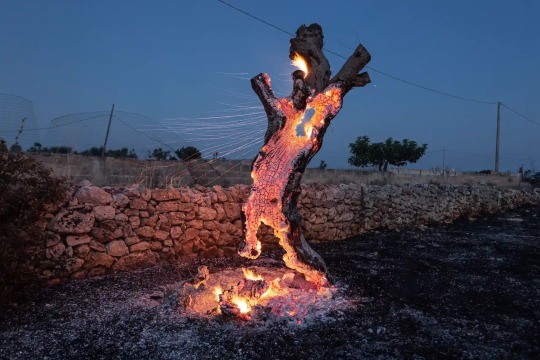
Filippo Ferraro, Wooden Diamonds! A burning trunk of an olive tree in the countryside near Felline, Italy. Since the beginning of this epidemic (when the plant bacterium Xylella fastidiosa began infecting olive trees), thousands of fields have been abandoned, causing a significant increase in fires, especially with the high temperatures of the summer. Photograph: Filippo Ferraro
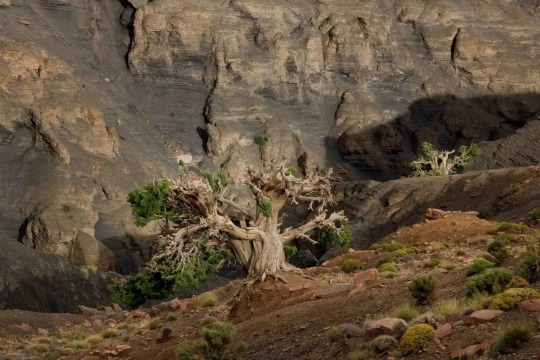
Robin Dodd, The Edge of Existence! An ancient juniper tree in the High Atlas mountains in Morocco. The goats and nomads have taken parts of the branches and foliage for food and firewood over the years but left enough of the tree to provide for future travellers. Photograph: Robin Dodd

Ellie Davies, Chalk Streams! Crystal clear chalk streams intertwine and weave throughout the counties of Dorset and Hampshire in southern England. There are just over 200 chalk streams globally, 85% of which are found in southern England. They are a unique ecosystem supporting a high biodiversity of wild creatures. Light reflected from the surface of the nearby sea is overlaid on to these river landscapes, creating a sparkling ingress. The transposed light symbolises rising sea levels as they insidiously impose themselves on these pristine landscapes. Photograph: Ellie Davies
0 notes
Text
Our mission is to provide our clients with a customized solution with the highest degree of customer service, professionalism, and quality of work. As the industry evolves, we know the importance of adapting to the changes and that is why we use some of the latest technology and equipment to ensure a successful outcome each time we step foot on your property. Our vast experience in the field of property maintenance allows us to provide exceptional service and accurate pricing each time.
Our services include: Property Maintenance, Excavation/Site Work, Seasonal Lawn Maintenance, Landscaping, and Snow Removal.
STEPS, Inc is centrally located in the Southern Tier to meet your immediate needs. Our target service zone for our discerning customers are the following New York and Pennsylvania Counties:
Allegany (NY), Cattaraugus (NY), Chautauqua (NY), Livingston (NY), Steuben (NY), Wyoming (NY), McKean (PA), and Potter (PA).

0 notes
Photo

Join us for "My True Colors" Plein Aire painting here & in Europe. September 1st through October 5th 2022. @countryside_gallery would like to invite you to our September 2022 Artist Exhibition featuring April Ann Bohmler. 2 South State Street Newtown Pennsylvania 18940 www.countrysideframes.com [email protected] 215.896.2246 Sunday - Monday 11am - 4pm Tuesday - Wednesday 10am - 6pm Thursday - Saturday 10am - 7pm Displayed artwork will be viewable at our 2 South Street location from September 1st through October 5th. https://fb.me/e/25wXNPaMJ A native of Bucks County, April Ann creates in her workshop home in Wrightstown, PA. Throughout her life April Ann itched to travel and visually experience the world; so she spends her time exploring and “Journaling Life” thru her art, a good amount of it in her home in Northern Spain. The light is different there, naturally. The light, culture, color, surroundings, and experiences are reflected in April's work. "Wherever I may be, I enjoy exploring how to represent the elements of life around me. It is an exploration of the world and bringing the inner visual image out on canvas. "The influence of April trekking in Northern Spain, Southern France, Morocco, Cuba, northern New York, London, England and Delft, Holland to name a few places are apparent in her work here locally; the color and inspiration comes through. "We take our past into our future. " Pastel is April's medium of choice for working en plein aire, selected for its rich color, texture and immediate results. Almost always you’ll find April sketching and painting local scenes with graphite, watercolor and ink; wherever she may be. It’s “Journaling of Life” it’s what she is about. #pastel #aprilann #newtownpa #gallery #portraits #pastelpainter #europe #painting #exhibition #newtown #buckscountypa #landscape #openingnight #fineartgallery #craypas #residentartist #chalkpastel #artist #travel #fineart #artistofinstagram (at Countryside Gallery & Custom Frame Design) https://www.instagram.com/p/CjOUy1qJg0J/?igshid=NGJjMDIxMWI=
#pastel#aprilann#newtownpa#gallery#portraits#pastelpainter#europe#painting#exhibition#newtown#buckscountypa#landscape#openingnight#fineartgallery#craypas#residentartist#chalkpastel#artist#travel#fineart#artistofinstagram
0 notes
Note
re:PA/pennsylvania: that's super interesting! i understand why PA would be easier to say since pennsylvania is a mouthful. are there any other oddities you noticed from your days as a call center? i'm from indiana so i always get super interested in the weirdness of the midwest, but honestly i just love any sort of regional language difference that arises over time.
Off the top of my head:
No one who isn't in one of the Pacific Coast states can say Oregon right, but it's especially bad with Southerners. (It's either "organ," like the body part or instrument, or "OR-ih-GIN"/"OR-ih-GUN" with the middle syllable barely voiced. "Ar-ee-gawn" is right out.)
Being from a rural-ish area where interrupting people is Rude with Corporate Mandates To Never Interrupt The Customer and Make Small Talk laid on top of that does not play well when speaking to folks from large cities like New York City, where's it's at least not rude to talk over someone to get things done faster and is rude to engage in smalltalk when they're there to solve a problem. (At least, this is my understanding. Like I say, I'm from a relatively rural area, but then again I also don't like small talk that distracts from what I'm trying to do.)
New Yorkers saying things like "badda bing, badda bip" is an exaggeration, but I did get one caller who actually did use that phrase and related ones. It took everything in me to not ask if he was in the mafia.
Boomhauer's accent is not an exaggeration. The two separate gents I spoke with who talked like him were from Louisiana.
Speaking of Louisana, they have parishes rather than counties, and get Real Mad when you ask them what county they're in (necessary to make the local channels work correctly sometimes).
I don't recall anything in particular about Indiana or the Midwest in general, but this may be for the same kinds of reasons I don't recall anything much about Oregon or the West Coast in general from the call centre days: my dad's from Kansas and I've visited a few times, so I'm already somewhat familiar with it. Some of the things I've osmosed from my dad include saying "worsh" instead of "wash" half the time (including talking about the state north of me, Worshington) and saying "crick" instead of "creek" for a small, shallow river. Dad also calls cicadas "circadas".
My own native Oregonian accent eats t's directly after n's. So, I'll say "Innernet" and "innercom" for "Internet" and "intercom". I think this is a thing in a lot of American English accents.
I also have a very strong cot/caught merger: the words "cot" and "caught" sound exactly the same in my accent, and trying to make them sound distinct makes my brain hurt.
23 notes
·
View notes
Text
Follow Your Dreams, My 70 Years as an Archaeologist
Archaeology usually conjures up Indiana Jones as an example of the thrills and dangers of archaeological research. Archaeology is a relatively safe occupation, although there are exceptions, such as the archaeologist who stood on top of a Mayan pyramid who was struck by lightning. There are many fields of archaeology that focus on geographic areas and time periods, from hunters and gatherers over hundreds of thousands of years to the last 10,000 years of the rise of civilizations around the world. There are many cultural specialties in archaeology such as Egyptology, Classical archaeology, focusing on the Mediterranean Greek and Roman, Mayan, Inca, U.S. Southwest and so forth. A field represented in Pittsburgh is Biblical archaeology at the Pittsburgh Theological Seminary with its Kelso Museum of Near Eastern Archaeology. At the University of Pittsburgh in the Department of Anthropology there is a focus on Mexico, Central and South America, Eastern Europe, China, and Central Asia with currently over 30 graduate students and faculty conducting research in these regions.
The Section of Anthropology of the Carnegie Museum of Natural History, for over 100 years, has conducted archaeological research in Egypt, Israel, Central Asia, Caribbean, Costa Rica, Peru, the Upper Ohio Valley and holds collections from other areas of the Americas and the world though donations or purchase. The richness of the Section’s collections can be seen in Walton Hall of Ancient Egypt, Polar World: Wyckoff Hall of Arctic Life, and Alcoa Foundation Hall of American Indians.
From an early age I wanted to be an archaeologist. My father was worried that archaeology wouldn’t provide much of a livelihood, so he arranged a visit with the director of the Peabody Museum at Harvard when I was a teenager. My father asked the director J. O Brew if one could make a living as an archaeologist and he answered, “it’s better if you’re independently wealthy.” This didn’t deter me from following my dream of becoming an archaeologist. My archaeological career is filled with luck and serendipity where seizing an offered archaeological opportunity or discovery of a significant artifact, not only guided my research, but where I worked. I have a parallel career in historic colonial sites and in prehistoric maritime adaptations. I became intrigued with archaeology at an early age visiting the Springfield Science Museum and joining a chapter of the Massachusetts Archaeological Society based at the museum. I went out on their excavations at sites in the Connecticut River Valley, one which was in 1957 in South Hadley where I learned how to uncover burials. From summering in the Lake George area of New York State I became interested in historic archaeology due to all the French and Indian War (1754-1763) forts in the region. In 1952 at age 16, I was a crew member for two summers at the excavations of Fort William Henry, made famous by James Fenimore Cooper’s novel The Last of the Mohicans.

Excavation of Fort William Henry at the Head of Lake George, New York 1952. (Photo Credit Dr. Richardson)

Fort William Henry was destroyed by French and Indian forces in 1757. In 1952, excavations and reconstruction of the fort began on what became a major tourist attraction. Photos show Dr. Richardson pointing to a photo of his 16-year-old self-excavating the site. (Photo Credit: Dr. David Watters)
I also summered on Martha’s Vineyard where in 1954 I dug at a coastal site with an associate of the Martha’s Vineyard Museum which stimulated my desire to become a maritime archaeologist. At St. Lawrence University I majored in Sociology and Anthropology and in 1957 I wrote a letter to the Smithsonian Institution asking to go on one of their expeditions and was accepted on a crew that set up a tent camp on the Big Bend of the Missouri River in South Dakota excavating at the Black Partisan village site. While at SLU I also was a crew member in 1959 at the excavations of Johnson Hall in Johnstown, NY, the home of Sir William Johnson, the British Superintendent of Indian Affairs during the French and Indian War.

Smithsonian Institution camp on the Lower Brule Sioux (Lakota) Indian Reservation in South Dakota, 1957. (Photo Credit: Dr. Richardson)

Dr. Richardson in the Smithsonian Camp 1957. (Photo Credit: Warren Caldwell)

Dr. Richardson lounging at the Black Partisan Site, an excavation of an earth lodge at Lower Brule Reservation. (Photo Credit: Warren Caldwell)

Dr. Richardson excavating a food storage pit at the Black Partisan Site. (Photo Credit: Warren Caldwell)
At Syracuse University for my master’s, I crewed in 1962-63 on 3 sites in up-state New York directed by William A. Ritchie, the State Archaeologist from the New York State Museum. I mentioned to him my interest in maritime archaeology and urged him to develop a research project on Martha’s Vineyard, which he did, excavating 6 sites from 1962-1966 on which I of course I participated. After Syracuse in 1963, I with my wife Judy went to the University of Illinois for my Ph.D. in northeastern U.S. archaeology, focusing on the maritime Vineyard. Here one of my advisors came out of his office and shouted down the hall to me “Jim, do you want to go to Peru?” To which I replied, “of course if you’re paying.” An excellent case of seizing the moment that fit well with my career goal of becoming a maritime specialist. In 1965 my wife Judy and I went to Talara, the second oldest operating oil field in the world after Drake well in western PA. Talara is 100 miles south of the Ecuadorian border and here I located an 8,000-year-old shell midden called Siches, which held evidence from warm and cold ocean fish and shellfish species. Based on the evidence at this coastal fishing and shellfish gathering society and other sites on the coast of Peru I and my colleague Dan Sandweiss, a Research Associate of the Section, developed the theory that this was evidence of a major shift in the change from a warm water to a cold water current washing the Peruvian north coast and the origins of El Niño around 5,800 years ago, the worldwide drought and flood disasters. My doctorate in 1969 was on the changing climate and coastal sites in the Talara region. I also dug in southern Peru at the Ring Site, an 10,500-year-old massive shell midden with cold water fish and shellfish. In addition, my students and I surveyed pyramid centers in the Talara area as well. I did return to Martha’s Vineyard in the early 80’s excavating 2 shell middens and a Colonial house site of missionaries to the Wampanoag. In western Pennsylvania in 1970 I directed a field school for the University of Pittsburgh at the Revolutionary War site of Hanna’s Town in Westmoreland County, the first County Seat west of the Alleghenies. This town of 30 log cabins and a fort was destroyed by an Iroquois and British attack in 1782. Here we excavated Charles Foreman’s tavern.

Dr. Richardson excavating Jackie Onassis’s property on Martha’s Vineyard in 1982. This site is called the Hornblower II Site. (Photo Credit: Jim Peterson)

Dr. Richardson in the cellar hole of the John and Experience Mayhew House Site c.1672-1658 on Martha’s Vineyard in 1985. (Phot Credit: Jim Peterson)

The Ring Site Ilo, Peru 1983 a 10,500-year-old Shell Midden. (Photo Credit: Dr. Richardson)

Dr. Richardson in the shell midden profile of the Ring Site, Peru. (Photo Credit: Daniel Sandweiss)
I came to the University of Pittsburgh in 1967, retiring in 2009. While at Pitt serving as chairman, I was approached by then director Dr. Craig Black to take over the chair of the Section of Anthropology in 1978 and accepted a half-time position as chief curator until my retirement in 2006. The only thing that has changed in my retirements was receiving a salary! I am currently writing up some sites from my Peruvian and Martha’s Vineyard research and have a book in press on a colonial site on Martha’s Vineyard where I am a board member of the museum. I am also still involved with Pitt graduate students and in programs at the Carnegie Museum of Natural History, so little has changed in my archaeological career since I first put a shovel in the ground in 1952.
Dr. James B. Richardson III is Curator Emeritus in the Section of Anthropology at Carnegie Museum of Natural History and University of Pittsburgh Anthropology Professor Emeritus. Museum employees are encouraged to blog about their unique experiences and knowledge gained from working at the museum.
#Carnegie Museum of Natural History#Archaeology#Archaeologist#Fort William Henry#Martha's Vineyard#Pittsburgh#University of Pittsburgh#Peru
124 notes
·
View notes
Link
LETTERS FROM AN AMERICAN
May 10, 2021
Heather Cox Richardson
A poll today by the Associated Press (AP) and the National Opinion Research Center (NORC) shows that President Joe Biden’s administration is gaining positive traction. Sixty-three percent of Americans approve of how he is handling his job as president. Seventy-one percent approve of how he is handling the coronavirus pandemic; 62% percent approve of how he is handling health care. Fifty-seven percent approve of how he is handling the economy; 54% approve of how he is handling foreign affairs.
Fifty-four percent of Americans think the country is going in the right direction. This is the highest number since 2017, but it is split by party: 84% of Democrats like the country’s direction, while only 20% of Republicans do.
Biden’s weak spots are in immigration, where 43% approve and 54% disapprove, and gun policy, where 48% approve and 49% disapprove.
And yet, Biden’s people have been working to address the influx of migrant children; White House Secretary Jen Psaki noted last week that “At the end of March, there were more than 5,000 children in Customs and Border Protection Patrol stations. Today, that number is approximately 600…. The amount of time children spend in CBP facilities is down by 75 percent — from 131 hours at the end of March to under 30 hours now.”
The administration has backed that short-term work with a long-term initiative. Last week, Vice President Kamala Harris met virtually with Mexican President Andrés Manuel López Obrador, the leader of the left of center populist nationalist coalition party MORENA, to talk about finding ways to promote economic development to address the root causes prompting the flight of refugees from Guatemala, Honduras, El Salvador and southern Mexico. They also talked about working together to protect human rights and dismantle the criminal networks that smuggle migrants. She will travel to Guatemala and Mexico in June, where she will meet with their leaders.
Disapproval of Biden’s gun policies might well reflect a desire for a stronger stance. In April, a Morning Consult/Politico poll showed that 64% of registered voters supported stricter gun control laws. We have had an average of ten mass shootings a week in 2021, 194 in all. (A mass shooting is one in which four people are killed or wounded.)
This week, Biden will be meeting with bipartisan groups of leaders, including Representative Kevin McCarthy (R-CA) and Senator Mitch McConnell (R-KY), to begin to hammer out an infrastructure measure based on his American Jobs Plan. He will also meet with Senators John Barrasso (R-WY), Roy Blunt (R-MO), Mike Crapo (R-ID), Pat Toomey (R-PA), Roger Wicker (R-MS), and Shelley Moore Capito (R-WV), who have proposed their own $568 billion proposal without corporate tax hikes.
As the good news from the administration is starting to filter into the media, bad news from the Trump wing of the Republican Party is also starting to get traction. On Saturday, we learned that at retreats in March and April, staff for the National Republican Congressional Committee refused to tell lawmakers how badly Trump is polling in core battleground districts, where 54% see Biden favorably while only 41% still favor Trump. Vice President Kamala Harris, the $1.9 trillion American Rescue Plan, and the $2.3 trillion American Jobs Plan are all more popular in those districts than the former president.
Indeed, it is more than a little odd that party leaders are bending over backward to tie their party to a former president who, after all, never broke 50% favorability ratings—the first time in polling history that had happened—and who lost both the White House and Congress.
Another set of data from Catalist, a voter database company in Washington, D.C., shows that the 2020 election was the most diverse ever, with Latino and Asian voters turning out in bigger numbers than ever before. Black voting increased substantially, while Asian-American and Pacific Islander voters had a decisive increase in turnout. The electorate was 72% white, down 2% from 2016 and 5% from 2008. Thirty-nine percent of Biden-Harris voters were people of color (61% were white); only 15% of Trump-Pence voters were POC (85% were white).
This demographic trend is behind the new voter suppression bills in Republican states. But the racial breakdown of the 2020 vote is not the only problem for the current Republican Party. The biggest turnout gains in 2020 were among young voters, 18 to 40 years old, who now make up 31% of voters, while those over 55 have dropped to only 44% of the electorate. Younger voters skew heavily toward the Democrats. Also notable was that women break heavily toward Democrats by a 10 point gap—79% of women of color support Democrats; 58% of white women voted for Biden-Harris—and women make up 54% of the electorate overall.
News out of the private “recount” in Arizona by Cyber Ninjas, a company without experience in election recounts and whose owner has already gone on record as believing that rigged voting machines in Arizona cost Trump victory, continues to be embarrassing as well. Although the Maricopa County Board of Supervisors, which has a Republican majority, said the count was fair and opposed a recount, sixteen Republicans in the state senate voted to give the ballots for Maricopa County, which includes Phoenix, to the company for a private recount. The count has been plagued by conspiracy theories—one observer claimed they are examining the ballots for signs of bamboo in the paper to show that tens of thousands of ballots were flown in from Asia—and it turned out that one of the people recounting the ballots had been at the January 6 riot at the Capitol. Now the “recount” is running so far behind it appears it won’t be done until August, rather than May 14 as the company promised.
State senator Paul Boyer, who voted for the “audit,” told New York Times reporter Michael Wines: “It makes us look like idiots…. Looking back, I didn’t think it would be this ridiculous. It’s embarrassing to be a state senator at this point.”
And then, this morning, the Washington Post dropped a long, investigative story by reporters Emma Brown, Aaron C. Davis, Jon Swaine, and Josh Dawsey revealing that the arguments former president Trump has grabbed to “prove” the election was stolen from him were part of a long conspiracy theory hatched in 2018 by Russell J. Ramsland, Jr., “a Republican businessman who has sold everything from Tex-Mex food in London to a wellness technology that beams light into the human bloodstream.” The story follows how Ramsland’s theories, which were debunked as “bat-s**t insane” by White House lawyers, got pumped into the media by Representative Louie Gohmert (R-TX) and Trump’s lawyer Rudy Giuliani, among others, and how Trump came to embrace them.
While Republican leaders are still standing behind those theories, and the former president, opponents of the party’s direction are pushing back not just against Trump but also against those leaders supporting him. Representative Adam Kinzinger (R-IL) tweeted this morning: “A few days before Jan 6, our GOP members had a conference call. I told Kevin [McCarthy] that his words and our party’s actions would lead to violence on January 6th. Kevin dismissively responded with ‘ok Adam, operator next question.’ And we got violence.”
Representative Liz Cheney (R-WY) has narrated a video distributed by the Republican Accountability Project recalling the violence of January 6, blaming Trump for spreading lies about the election, and reminding viewers that more than 60 lawsuits disproved his claims that the election was stolen. The video says “we are the party of Lincoln. We are not the party of QAnon” (showing an image of Jacob Chansley, the so-called “QAnon Shaman,” who wore a horned headdress during the Capitol insurrection) “or white supremacy” (showing an image of Fox News Channel personality Tucker Carlson). “We cannot embrace insurrection” (showing a picture of Georgia Republican Representative Marjorie Taylor Greene). “President Trump provoked an attack on the United States Capitol which resulted in five people dying. That is a person who does not have a role as a leader of our party going forward.” The video features an image of McCarthy standing with Trump. Cheney made it clear she was not about to shut up.
This afternoon, McCarthy released a statement calling for Cheney’s ouster as conference chair, featuring the line: “[u]nlike the left, we embrace free thought and debate.” (References to George Orwell, who famously wrote about how fascists used language to rewrite history, were all over Twitter.) McCarthy and other Trump loyalists have suggested that Cheney needs to go because she keeps talking about the past, but Allan Smith of NBC News points out that Trump himself seems to be the one who cannot stop talking about the past.
—-
LETTERS FROM AN AMERICAN
HEATHER COX RICHARDSON
#political#corrupt GOP#criminal GOP#January 6 2021#insurrection#Liz Cheney#Biden Administration#Heather Cox Richardson#Letters From An American
6 notes
·
View notes
Text

First purple coneflower bloom of the season!
30 May 2024
#purple coneflower#coneflower#echinacea#southern York County PA#pennsylvania#southeastern PA#May 2024
0 notes
Text
His Old Tribulations, Our Current Struggle: Remembering Garner in the Current Call to Reform Cannabis Laws
This post was written by Warner Sabio Sr., Graduate Student, Jazz Studies, University of Pittsburgh.
Recently, on April 7th, Virginia’s legislature passed a bill legalizing the possession of small amounts of marijuana, making it the 16th state to do so. Under Virginia’s law, adults can possess an ounce or less of marijuana beginning July 1. Several weeks before, New York passed the Marijuana Regulation and Taxation Act, legalizing the recreational use of marijuana in the state. New York’s legislation also expunges the records of people convicted on marijuana-related charges that are no longer criminalized. These two drug-policy reforms concerning marijuana are a few of the many looking to respond to the disproportionate and often tragic impact previous legislation has had on communities of color.
For Erroll Garner, the drug policies regarding marijuana and the enforcement of those laws affected him personally and professionally. On January 26, 1946, Garner was arrested in Los Angeles and charged with violating section 11500 of the California Health and Safety Code—a felony at the time. The State accused Garner of possessing “flowering tops and leaves of Indian Hemp (Cannabis Sativa)” and set bail at $500. According to dollartimes.com, adjusted for inflation, $500 in 1946 is equal to $7,156 in 2021. An excessive amount, it seems, for the non-violent crime he was accused of committing. Nevertheless, on April 10, 1946, Garner pled guilty to the charge and was sentenced to 90 days in the county jail. This incident would mark Garner as a felon and a “dope addict,” in the problematic wording of the language that circulated in press accounts. The distinction would continue to cast its shadow and haunt the pianist for at least another decade, if not the rest of his life.
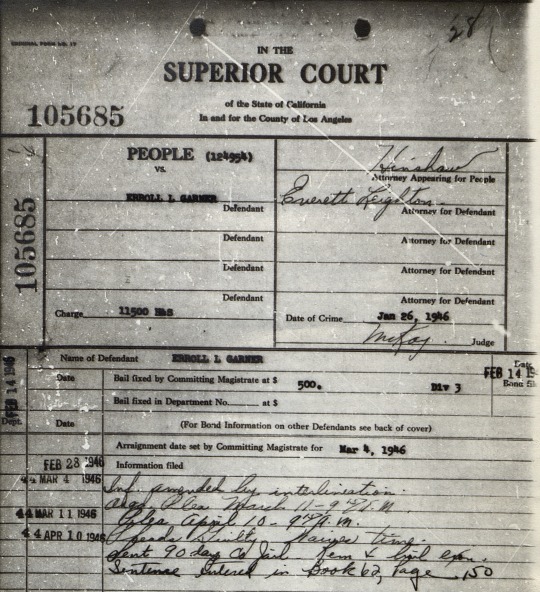
(Above) Page 1, (Below) Page 2, Page 3, Page 4, and Page 11 from folder “Erroll Garner Personal,” Erroll Garner Archive, 1942-2010, AIS.2015.09, Box 3, Folder 18, Archives & Special Collections, University of Pittsburgh Library System.


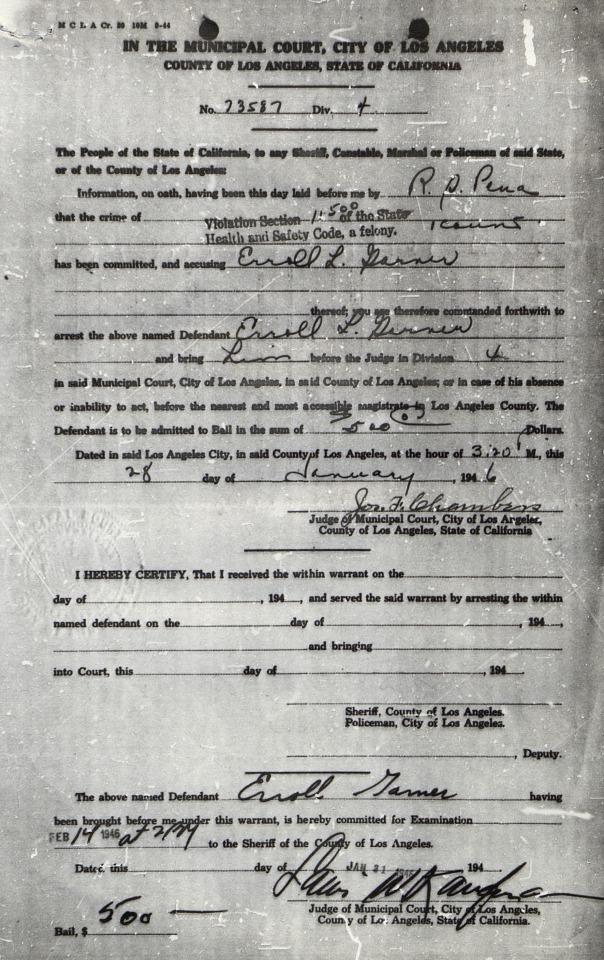
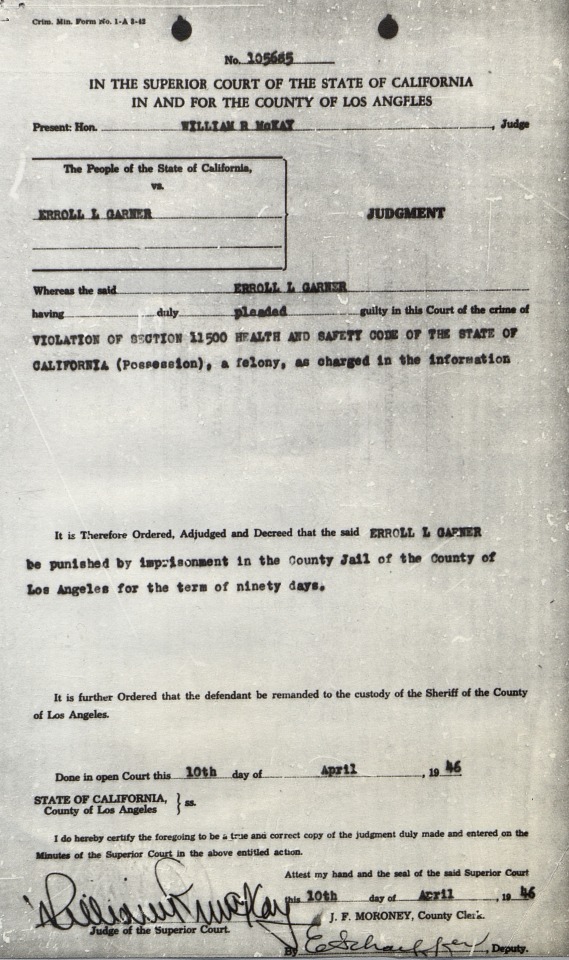
Six years later, after a performance at Mack’s Tavern in Atlantic City on September 12, 1952, the pianist was again arrested and brought up on charges surrounding a marijuana-related drug bust. According to The Baltimore Afro-American, Garner was held “for failure to register as a convicted addict under the state’s narcotics registration law and not for being an actual user of narcotics.”[1] The conviction referred to by New Jersey law-enforcement authorities was based on Garner’s 1946 Los Angeles arrest, which he reportedly informed authorities of at the time. Interestingly, Garner, convicted of possessing marijuana in the initial Los Angeles case, was now branded a “dope addict” in press coverage revolving around the Atlantic City incident.

(Above) Image of the article from The Baltimore Afro-American, Sept. 13, 1952.
The headline on the front page of September 13, 1952, Pittsburgh Courier read: “ARREST ERROLL GARNER FOR DOPE.” The subhead for the article noted that Garner was “Part of Big-Time Roundup.” The lede stated:
ATLANTIC CITY – Erroll Garner, Pittsburgh’s significant gift to jazz and dexterous piano-playing, was nabbed here in a post-Labor Day roundup of alleged dope addicts and suspects.”[2]
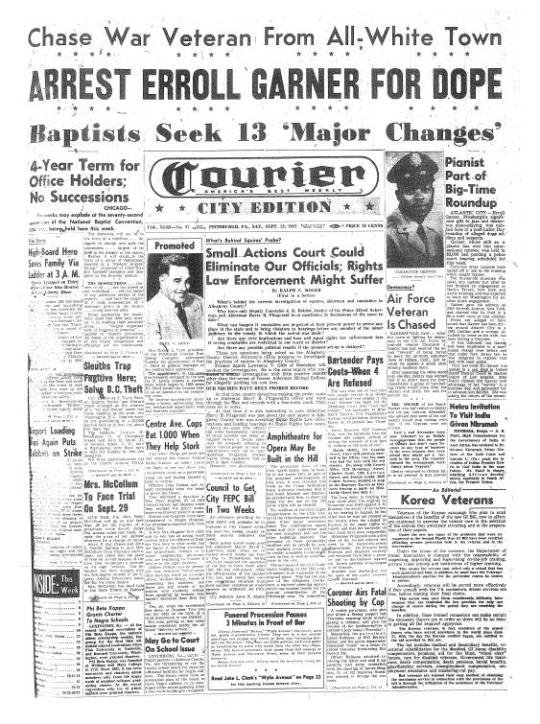
(Above) The Pittsburgh Courier, Sept. 13, 1952.
The Courier also reported that forty-one other suspects were also arrested. One of those arrested included Garner’s roommate and valet, Frank (Tons) Randolph, who was accused of “being a dope peddler.” The Afro-American reported Randolph “was placed under $25,000 bail after two witnesses testified in Municipal Court on Monday that they bought marihuana in $10 and $20 lots from him.” According to dollartimes.com, adjusted for inflation, $25,000 in 1952 is equal to $245,730 in 2021. From the reports, it does not appear that authorities found any weed on Garner or Randolph. Nevertheless, it seems the testimony was enough to warrant the arrests.
It is also interesting to note that the Courier report hinted at a possible ulterior motive for the arrest. Perhaps stemming from the practice of racial profiling of Black men driving nice cars, the paper reported, “police are alleged to have stated that Garner has been driving around Atlantic City in a 1952 Cadillac and a woman, described by some as his wife has been driving a Chrysler.”
In a follow-up story on September 20, The Afro-American interviewed Garner about the arrest. The headline read: “GARNER SHRUGS OFF DOPE COUNT ARREST: ‘Just One Of Those Things,’ Pianist Says of Shore Incident.”[3] Garner discusses the Los Angeles case in the piece, affirming his conviction (saying it took place in 1943) and stating he was “sentenced to 45 days to an honor farm.” Garner elaborated:
“It was all a ‘frame.’ I was turned in by a fellow whose job I took in a night club in which I was playing. The guy was salty and squealed. But I am not complaining because it did happen. At the time, I was a youngster and went around with a bunch of wild guys.”

(Above) Headline from The Baltimore Afro-American, Sept. 20, 1952.
As for the Atlantic City incident, Garner was quoted as saying he “was through with that kind of stuff now” and had “too much to lose.” However, he was critical of the publicity, stating, “the only thing is that I was the least involved and got most of the publicity. This is one time that I wished I was digging ditches.”
Almost a month after the Atlantic City arrest, on October 11, 1952, The Afro-American reported that Garner was fined $50 for failure to register as a dope addict.[4] The case was thereafter dismissed, and Garner “filed the necessary registration forms in compliance with the local ordinance. According to the paper, the incident had left Garner feeling “disturbed” and “embarrassed.” Garner was forced to cancel several weeks of bookings “in order to permit him to rest” because he was “suffering from nervous exhaustion.” As for Randolph and the others arrested that night, my limited search came up empty as to how they fared.
On Jan.17, 1953, the Courier reported that a case involving Garner’s arrest in St. Louis on New Year’s Eve was tossed. Garner was charged with possession of narcotics.[5] The paper said, “Garner’s case was thrown out of court because the officers did not have a warrant when the arrest was made.” Garner’s attorney, however, clarified that the basis of the arrest was “a crank telephoned St. Louis police that the pianist had carried narcotics from New York to St. Louis in his automobile. It was revealed that Garner had arrived in this city by plane.”
For Pittsburgh-born Garner, professional success could not shield him from the insatiable appetite to punish that has driven much of the nation’s drug policies for decades. Major players in the formation of these early policies are uniquely linked to Garner geographically. Harry J. Anslinger, who served as the first commissioner of the U.S. Treasury Department’s Federal Bureau of Narcotics, was an Altoona, PA native. Pittsburgh’s-own Andrew Mellon, the uncle of Anslinger’s wife, appointed him to the post. Mellon, at the time of Anslinger’s appointment, was the Treasury Secretary.
According to The Economist:
“The drafters of the Harrison Act of 1914, the first federal ban on non-medical narcotics, played on fears of ‘drug-crazed, sex-mad negroes.’ And the 1930s campaign against marijuana was coloured by the fact that Harry Anslinger, the first drug tsar, was appointed by Andrew Mellon, his wife’s uncle. Mellon, the Treasury Secretary, was banker to DuPont, and sales of hemp threatened that firm’s efforts to build a market for synthetic fibers. Spreading scare stories about cannabis was a way to give hemp a bad name. Moral outrage is always more effective if backed by a few vested interests.”[6]
According to law professor Michael Vitello, “while the Harrison Act did not include a prohibition against marijuana, its framework would become the model for Congress’s first efforts to criminalize marijuana.”[7]

(Above) Harry J. Anslinger served as the first commissioner of Treasury Department’s Federal Bureau of Narcotics. Image from the Associated Press.
Driven by stereotypes, some framers of early U.S. drug policies linked the usage of both marijuana and cocaine to marginalized communities and racialized “fringe groups like pimps, prostitutes, and day laborers” and “uppity Southern blacks and race-mixing drug parties.”[8] Concerning Anslinger’s beliefs, Vitello states:
“Finding racist quotations attributed to Anslinger is easy and a reminder of how ingrained racist language was in this country. Here are a few choice quotations: “Reefer makes darkies think they’re as good as white men”; “Marihuana influences Negroes to look at white people in the eye, step on white men’s shadows and look at a white woman twice”; and “There are 100,000 total marijuana smokers in the U.S., and most are Negroes, Hispanics, Filipinos and entertainers. Their Satanic music, jazz and swing result from marijuana use. This marijuana causes white women to seek sexual relations with Negroes, entertainers and any others.”[9]
These antiquated and racist beliefs would vibrantly pulsate through the heart of drug laws for generations. Unfortunately, Garner’s experience was not isolated or rare. For Garner, the arrests and court cases must have been taxing. His experience speaks for many people caught up in the web of draconian drug laws pervading the justice system. The growing frustration has led to calls for change.
As previously mentioned, recent efforts have yielded changes to drug policy concerning marijuana across the United States. To date, sixteen states, two territories, and the District of Columbia have legalized small amounts of marijuana for adult recreational use. Twenty-seven states have decriminalized weed, meaning, “small, personal-consumption amounts are a civil or local infraction, not a state crime (or are a lowest misdemeanor with no possibility of jail time).”[10] However, more needs to be done to undo the gross injustice that lopsided enforcement has produced. It is a flawed system of policies and laws that impacted Garner then and thousands today. We must resolve the discordant tones struck by the framers of foundational drug war policies, the effects of which still resonate and impact civil society today.
Works Cited
Erroll Garner Archive, 1942-2010, AIS.2015.09, Archives & Special Collections, University of Pittsburgh Library System.
“Arrest Erroll Garner For Dope: Pianist Part of Big-Time Roundup.” Pittsburgh Courier (Pittsburgh, Pa.), September 13, 1952: 1.
Bender, Steven W. “Joint Reform? The Interplay of State, Federal, and Hemispheric Regulation of Recreational Marijuana and Failed War on Drugs.” Albany Law Environmental Outlook 6, no. 2 (2013): 359–.
“Errol Garner Case Thrown Out of Court.” Pittsburgh Courier (Pittsburgh, Pa.), January 17, 1953: 1.
“Errol Garner Pays $50 Fine: Failed To Register As Dope Addict.” Baltimore Afro-American (Baltimore, Md), October 11, 1952: 9
“Garner Shrugs Off Dope Count Arrest: ‘Just One Of Those Things,’ Pianist Says Of Shore Incident.” Baltimore Afro-American (Baltimore, Md), September 20, 1952: 3
Gootenberg, Paul. Andean Cocaine: The Making of a Global Drug. Chapel Hill, NC: University of North Carolina Press, 2008.
“‘How did we get here?’ A Survey of Illegal Drugs.” Economist, July 28, 2001, p. 4. The Economist Historical Archive, 1843-2015 (accessed April 13, 2021). https://link-gale-com.pitt.idm.oclc.org/apps/doc/GP4100323851/ECON?u=upitt_main&sid=ECON&xid=779492d4.
“Pianist Under Bail For Not Registering As Addict; Shore’s Raids Called Biggest.” Baltimore Afro-American (Baltimore, Md), September 13, 1952: 1
National Conference of State Legislatures website, https://www.ncsl.org/research/civil-and-criminal-justice/marijuana-overview.aspx
Vitiello, Michael. “Marijuana Legalization, Racial Disparity, and the Hope for Reform.” Lewis & Clark Law Review 23, no. 3 (2019): 789-822.
[1] “Pianist Under Bail For Not Registering As Addict; Shore’s Raids Called Biggest,” Baltimore Afro-American (Baltimore, Md), September 13, 1952.
[2] “Arrest Erroll Garner For Dope: Pianist Part of Big-Time Roundup,” Pittsburgh Courier (Pittsburgh, Pa.), September 13, 1952.
[3] “Garner Shrugs Off Dope Count Arrest: ‘Just One Of Those Things,’ Pianist Says Of Shore Incident,” Baltimore Afro-American (Baltimore, Md), September 20, 1952.
[4] “Errol Garner Pays $50 Fine: Failed To Register As Dope Addict.” Baltimore Afro-American (Baltimore, Md), October 11, 1952.
[5] “Errol Garner Case Thrown Out of Court.” Pittsburgh Courier (Pittsburgh, Pa.), January 17, 1953: 1.
[6] “‘How did we get here?’ A Survey of Illegal Drugs,” Economist, July 28, 2001.
[7] Michael Vitiello, “Marijuana Legalization, Racial Disparity, and the Hope for Reform,” Lewis & Clark Law Review 23, no. 3 (2019), 794.
[8] Paul Gootenberg, Andean Cocaine: The Making of a Global Drug, Chapel Hill, NC: University of North Carolina Press, 2008, 193.
[9] Vitiello, “Marijuana Legalization,” 799.
[10] National Conference of State Legislatures website, https://www.ncsl.org/research/civil-and-criminal-justice/marijuana-overview.aspx
#erroll garner tuesdays#erroll garner#criminalization#newspapers#cannabis laws#drug policy#harry anslinger#racism
3 notes
·
View notes
Photo










High above the Susquehanna River, PA (No. 2)
"Susquehanna" comes from the Len'api (or Delaware Indian) term Sisa'we'hak'hanna, which means "Oyster River." Oyster beds were widespread in the bay near the mouth of the river, which the Lenape farmed. They left oyster shell middens at their villages.
The Len'api were an Algonquian-speaking Native American people who had communities ranging from coastal Connecticut through New York and Long Island, and further south into New Jersey and Delaware in the mid-Atlantic area. Their settlements in Pennsylania included Con'esto'ga ("Roof-place" or "town," modern Washington Boro, Lancaster County), also called Ka'ot'sch'ie'ra ("Place-crawfish," modern Chickisalunga, Lancaster County), or Gasch'guch'sa ("Great-fall-in-river," modern Conewago Falls, Lancaster County). They were called Minquas ("quite different"), or Sisa'we'hak'hanna'lenno'wak ("Oyster-river-people") by others. The Len'api also called the area Sisa'we'hak'hanna'unk ("Oyster-river-place").
Peoples of the mid-Atlantic Coast included coastal peoples who spoke Algonquian languages, such as the Len'api (whose bands spoke three dialects of Lenape), and Iroquoian languages-speaking peoples of the interior, such as the Eroni and the Five Nations of the Iroquois League, or Haudenosaunee. The English of Pennsylvania referred to the Eroni people of Conestoga as "Susquehannocks" or "Susquehannock Indians," a name derived from the Lenape term. In addition, John Smith of Jamestown, Virginia, labeled their settlement as "Sasquesahanough" on his 1612 map when he explored the upper Chesapeake Bay area.
In Virginia and other southern colonies, Siouan-speaking tribes constituted a third major language family, with their peoples occupying much of the middle areas of the interior. Iroquoian speakers, such as the Cherokee and Tuscarora peoples, generally occupied areas to the interior near the Piedmont and foothills.
Source: Wikipedia
#Susquehanna River#Columbia#Chickies Rock County Park#Pennsylvania#summer 2019#original photography#landscape#vista point#countryside#water#rapids#landmark#tourist attraction#hills#forest#woods#tree#travel#vacation#Breezyview Gazebo#Rosebud Island#view#flora#nature#blue sky#clouds#lawn#USA#York County
3 notes
·
View notes
Text
William Wright, Abolitionist
WILLIAM WRIGHT
See p. 691.
MEMORIAL.
William Wright, a distinguished abolitionist of Adams county, Pennsylvania, was born on the 21st of December, 1788. Various circumstances conspired to make this unassuming Quaker an earnest Abolitionist and champion of the oppressed in every land and of every nationality and color. His uncle, Benjamin Wright, and cousin, Samuel B. Wright, were active members of the old Pennsylvania Abolition Society, and at the time of the emancipation of the slaves in this state were often engaged in lawsuits with slave-holders to compel them to release their bondmen, according to the requirements of the law. William Wright grew up under the influence of the teachings of these relatives. Joined to this, his location caused him to take an extraordinary interest in Underground Rail Road affairs. He lived near the foot of the southern slope of the South Mountain, a spur of the Alleghenies which extends, under various names, to Chattanooga, Tennessee. This mountain was followed in its course by hundreds of fugitives until they got into Pennsylvania, and were directed to William Wright's house.
In November, 1817, William Wright married Phebe Wierman, (born on the 8th of February, 1790,) daughter of a neighboring farmer, and sister of Hannah W. Gibbons, wife of Daniel Gibbons, a notice of whom appears elsewhere in this work. Phebe Wright was the assistant of her husband in every good work, and their married life of forty-eight years was a long period of united and efficient labor in the cause of humanity. She still (1871) survives him. William and Phebe Wright began their Underground Rail Road labors about the year 1819. Hamilton Moore, who ran away from Baltimore county, Maryland, was the first slave aided by them. His master came for him, but William Wright and Joel Wierman, Phebe Wright's brother, who lived in the neighborhood, rescued him and sent him to Canada.
In the autumn of 1828, as Phebe Wright, surrounded by her little children, came out upon her back porch in the performance of some household duty, she saw standing before her in the shade of the early November morning, a colored man without hat, shoes, or coat. He asked if Mr. Wright lived there, and upon receiving an affirmative reply, said that he wanted work. The good woman, comprehending the situation at a glance, told him to come into the house, get warm, and wait till her husband came home. He was shivering with cold and fright. When William Wright came home the fugitive told his story. He came from Hagerstown, Maryland, having been taught the blacksmith's trade there. In this business it was his duty to keep an account of all the work done by him, which record he showed to his master at the end of the week. Knowing no written character but the figure 5 he kept this account by means of a curious system of hieroglyphics in which straight marks meant horse shoes put on, circles, cart-wheels fixed, etc. One day in happening to see his master's book he noticed that wherever five and one were added the figure 6 was used. Having practiced this till he could make it he ever after used it in his accounts. As his master was looking over these one day, he noticed the new figure and compelled the slave to tell how he had learned it. He flew into a rage, and said, "I'll teach you how to be learning new figures," and picking up a horse-shoe threw it at him, but fortunately for the audacious chattel, missed his aim. Notwithstanding his ardent desire for liberty, the slave considered it his duty to remain in bondage until he was twenty-one years old in order to repay by his labor the trouble and expense which his master had had in rearing him. On the evening of his twenty-first anniversary he turned his face toward the North star, and started for a land of freedom. Arriving at Reisterstown, a village on the Westminster turnpike about twenty-five miles from Baltimore and thirty-five miles from Mr. Wright's house, he was arrested and placed in the bar-room of the country tavern in care of the landlady to wait until his captors, having finished some work in which they were engaged, could take him back to his master. The landlady, being engaged in getting supper, set him to watch the cakes that were baking. As she was passing back and forth he ostentatiously removed his hat, coat, and shoes, and placed them in the bar-room. Having done this, he said to her, "I will step out a moment." This he did, she sending a boy to watch him. When the boy came out he appeared to be very sick and called hastily for water. The boy ran in to get it. Now was his golden opportunity. Jumping the fence he ran to a clump of trees which occupied low ground behind the house and concealing himself in it for a moment, ran and continued to run, he knew not whither, until he found himself at the toll gate near Petersburg, in Adams county. Before this he had kept in the fields and forests, but now found himself compelled to come out upon the road. The toll-gate keeper, seeing at once that he was a fugitive, said to him, "I guess you don't know the road." "I guess I can find it myself," was the reply. "Let me show you," said the man. "You may if you please," replied the fugitive. Taking him out behind his dwelling, he pointed across the fields to a new brick farm-house, and said, "Go there and inquire for Mr. Wright." The slave thanked him and did as he was directed.
He remained with William Wright until April, 1829. During this short time he learned to read, write, and cipher as far as the single rule of three, as it was then called, or simple proportion. During his residence with William Wright, nothing could exceed his kindness or gratitude to the whole family. He learned to graft trees, and thus rendered great assistance to William Wright in his necessary business. When working in the kitchen during the winter he would never allow Phebe Wright to perform any hard labor, always scrubbing the floor and lifting heavy burdens for her. Before he went away in the spring he assumed a name which his talents, perseverance, and genius have rendered famous in both hemispheres, that of James W.C. Pennington. The initial W. was for his benefactor's family, and C. for the family of his former master. From William Wright's he went to Daniel Gibbons', thence to Delaware county, Pennsylvania, and from there to New Haven, Conn., where, while performing the duties of janitor at Yale College, he completed the studies of the college course. After a few years, he went to Heidelberg, where the degree of D.D. was conferred upon him. He never forgot William Wright and his family, and on his return from Europe brought them each a present. The story of his escape and wonderful abilities was spread over England. An American acquaintance of the Wright family was astonished, on visiting an Anti-slavery fair in London many years ago, to see among the pictures for sale there, one entitled, "William and Phebe Wright receiving James W.C. Pennington." The Dr. died in Florida, in 1870, where he had gone to preach and assist in opening schools amongst the Freemen.
In 1842 a party of sixteen slaves came to York, Pa., from Baltimore county, Md. Here they were taken in charge by William Wright, Joel Fisher, Dr. Lewis, and William Yocum. The last named was a constable, and used to assist the Underground Rail Road managers by pretending to hunt fugitives with the kidnappers. Knowing where the fugitives were he was enabled to hunt them in the opposite direction from that in which they had gone, and thus give them time to escape. This constable and a colored man of York took this party one by one out into Samuel Willis' corn-field, near York, and hid them under the shocks. The following night Dr. Lewis piloted them to near his house, at Lewisburg, York county, on the banks of the Conewago. Here they were concealed several days, Dr. Lewis carrying provisions to them in his saddle-bags. When the search for them had been given up in William Wright's neighborhood, he went down to Lewisburg and in company with Dr. Lewis took the whole sixteen across the Conewago, they fording the river and carrying the fugitives across on their horses. It was a gloomy night in November. Every few moments clouds floated across the moon, alternately lighting up and shading the river, which, swelled by autumn rains, ran a flood. William Wright and Dr. Lewis mounted men or women behind and took children in their arms. When the last one got over, the doctor, who professed to be an atheist, exclaimed, "Great God! is this a Christian land, and are Christians thus forced to flee for their liberty?" William Wright guided this party to his house that night and concealed them in a neighboring forest until it was safe for them to proceed on their way to Canada.
Just in the beginning of harvest of the year 1851, four men came off from Washington county, Maryland. They were almost naked and seemed to have come through great difficulties, their clothing being almost entirely torn off. As soon as they came, William Wright went to the store and got four pair of shoes. It was soon heard that their masters and the officers had gone to Harrisburg to hunt them. Two of them, Fenton and Tom, were concealed at William Wright's, and the other two, Sam and one whose name has been forgotten, at Joel Wierman's. In a day or two, as William Wright, a number of carpenters, and other workmen, among whom were Fenton and Tom, were at work in the barn, a party of men rode up and recognized the colored men as slaves of one of their number. The colored men said they had left their coats at the house. William Wright looked earnestly at them and told them to go to the house and get their coats. They went off, and one of them was observed by one of the family to take his coat hastily down from where it hung in one of the outhouses, a few moments afterward. After conversing a few moments at the barn, William Wright brought the slave-holders down to the house, where he, his wife and daughters engaged them in a controversy on the subject of slavery which lasted about an hour. One of them seemed very much impressed, and labored hard to convince his host that he was a good master and would treat his men well. Finally one of the party asked William Wright to produce the men. He replied that he would not do that, that they might search his premises if they wished to, but they could not compel him to bring forth the fugitives. Seeing that they had been duped, they became very angry and proceeded forthwith to search the house and all the outhouses immediately around it, without, however, finding those whom they sought. As they left the house and went toward the barn, William Wright, waving his hand toward the former, said, "You see they are not anywhere there." They then went to the barn and gave it a thorough search. Between it and the house, a little away from the path, but in plain sight, stood the carriage-house, which they passed by without seeming to notice. After they had gone, poor Tom was found in this very house, curled up under the seats of the old-fashioned family carriage. He had never come to the house at all, but had heard the voices of his hunters from his hiding-place, during their whole search. About two o'clock in the morning, Fenton was found by William Wright out in the field. He had run along the bed of a small water course, dry at that time of year, until he came to a rye field amid whose high grain he hid himself until he thought the danger was past. From William Wright's the slave-catchers went to Joel Wierman's, where, despite all that could be done, they got poor Sam, took him off to Maryland and sold him to the traders to be taken far south.
In 1856 William Wright was a delegate from Adams county to the Convention at Philadelphia which nominated John C. Fremont for President of the United States. As the counties were called in alphabetical order, he responded first among the Pennsylvania delegation. It is thought that he helped away during his whole life, nearly one thousand slaves. During his latter years, he was aided in the good work by his children, who never hesitated to sacrifice their own pleasure in order to help away fugitives.
His convictions on the subject of slavery seem to have been born with him, to have grown with his growth, and strengthened with his strength. He could not remember when he first became interested in the subject.
William Wright closed his long and useful life on the 25th of October, 1865. More fortunate than his co-laborer, Daniel Gibbons, he lived to see the triumph of the cause in which he had labored all his life. His latter years were cheered by the remembrance of his good deeds in the cause of human freedom. Modest and retiring, he would not desire, as he does not need, a eulogy. His labors speak for themselves, and are such as are recorded upon the Lamb's Book of Life.
####################################################
Album of pix of Plainfield w interior> https://goo.gl/photos/UKfYAyysNzACjBVF9
##########################################
The Wright House is located on property owned by Ludwigs on the northernmost end of Adams County in Latimore Township. It's along Latimore Valley Road, set back in a bit. I have never seen it in person, so I don't know what condition it is currently in. It is on private property, which is why I do not give the location of the house on my website. The black and white photos are from the 1920s and the color photos are from 1993. It played a part in the underground railroad and at least one of the photos shows where slaves would have hidden. My Dad said he was back there when he was little and they pulled the dresser away to reveal the crawl space behind it. I think William and Phebe Wright were the ones who owned it, hence the name, the "Wright House." I don't know anything about them, though, off-hand. The house looks like it would have been a nice place if it had been fixed up, but I imagine it's beyond repair at this point.
-from email from D. Worley
2 notes
·
View notes
Text
Understanding Fossil Fuels through Carnegie Museums’ Exhibits
by Albert D. Kollar, Collection Manager, with assistance from Suzanne Mills, Collection Assistant, and Joann Wilson, Volunteer Section of Invertebrate Paleontology
The exhibits of Carnegie Museum of Natural History and Carnegie Museum of Art are ideal for a multidisciplinary study of fossil fuels in Pennsylvania and beyond. Such a study must properly begin with some historical background about the landmark Oakland building that houses both museums, as well as some background information about fossil fuels.
When the Carnegie Library of Pittsburgh opened in 1895, the architects, Longfellow, Alden, and Harlow incorporated roof skylights for maximum daytime lighting in the Italian Renaissance designed building¹. Nighttime activities were illuminated by interior gas lighting fixtures, possibly supplied by the Murrysville gas field, which began production in 1878. With the opening of the Carnegie Institute Extension in 1907, the Bellefield Boiler Plant was built in Junction Hollow to supply in-house steam heat and electricity from bituminous coal¹. From the 1970’s, coal and natural gas had been used to heat the boilers that supply heat to the Oakland Campus, Phipps, the University of Pittsburgh and the Oakland hospitals. In 2009 coal was eliminated as a fuel source. Electricity on the other hand, is supplied through Talen Energy from multiple sources (coal, gas, and renewable energy sources). For the future, Carnegie Museums of Pittsburgh plans to receive its electricity from renewable solar energy via Talen Energy².
What are Fossil Fuels?
Coal, oil, and natural gas (methane), known collectively as fossil fuels, are sources of energy derived from the remains of ancient life forms that usually are found preserved in coal rock, black shale, and sandstone.

Figure 1.
Coal is a rock. The coalification process starts from a thick accumulation of plant material in reducing environments where the organic matter does not decay completely. This deposit of plant residue that thrives in freshwater swamps at high latitudes forms peat, an early stage or rank in the development of coal. With the burial of peat over geologic time and a low temperature form of metamorphism produces a progression of the maturity or “rank” of the organic deposits that form the coal ranks of lignite, sub-bituminous, bituminous, and anthracite³ (Fig. 1). The Pennsylvanian Period was named for the rocks and coals of southwestern Pennsylvania that formed more than 300 million years ago.
Oil and natural gas, collectively known as hydrocarbons, were forming in the Devonian rocks of Pennsylvania between 360 and 390 million years ago. These hydrocarbon deposits or kerogens are made of millions of generations of marine plankton and animal remains that accumulated in a restricted anoxia ocean basin that extended from southern New York, through western Pennsylvania, northern West Virginia to eastern Kentucky⁴. The thick layers of sediment formed black shales or mud rocks such as the Marcellus Shale. Black shales are rich in oil and gas and are called source rocks. Sandstones such as the Oriskany Sandstone that is older than the Marcellus Shale is a reservoir rock. An amorphous mass of organic matter or kerogen undergo complex geochemical reshuffling of the hydrocarbon molecules first with burial then by thermal “cracking” as heat and pressure through the geologic process of metamorphism over millions of years transform kerogen into modern day fossil fuels⁴.
Fossil Fuels in Modern Society
As commodities converted to fuels for our modern world, these resources account for 80% of today’s energy consumption in the United States⁵. All three fossil fuels, in furnaces of vastly different design, have been used to directly heat homes, schools, workplaces, and other structures. In power plants, all three have been used for generating electricity for lighting, charging mobile phones, and powering computers, home appliances, and all manner of industrial machines. In the United States, coal became the country’s primary energy source in the late 1880s, displacing the forest-destroying practice of burning wood. It ceded the top spot to petroleum in 1950 but enjoyed a late-20th-century renaissance as the primary fuel for power plants⁵. Coal now generates approximately 11% of our country’s supply down from 48% just 20 years ago. Natural gas is currently used to generate approximately 35% of US electricity supplanting the use of coal⁶. While petroleum is less than1%⁶.
Transportation accounts for approximately 37% of total energy consumption. Coal played an historic role in powering railroads, and both compressed natural gas and batteries (charged with electricity generated from various sources) are of growing importance, however, refined oil products currently power 91% of the transportation sector⁶.

Figure 2.
In the early 20th century, scientists warned about how the burning of coal could create global warming in future centuries by raising the level of carbon dioxide, a greenhouse or heat-holding gas, in the atmosphere. (Fig. 2). It took less than a century for evidence to mount of climate change associated with the burning of fossil fuels, the clearing of forests associated with industrial scale livestock production, and from waste management and other routine processes of modern life. In recent decades headlines have routinely proclaimed the risks of a warming planet, including damage to terrestrial ecosystems, the oceans, and a rise in sea level⁷.
Fossil Fuels and Museum Geology Displays
When architects Frank E. Alden and Alfred B. Harlow designed the Carnegie Institute Extension (1907), they incorporated Andrew Carnegie’s vision to create an introduction hall to the museum named Physics, Geology and Mineralogy⁸. This hall (the forerunner to Benedum Hall of Geology) was intended to introduce Pittsburghers to the regional natural history subjects of geology, paleontology, and economic geology (fossil fuels)⁹.
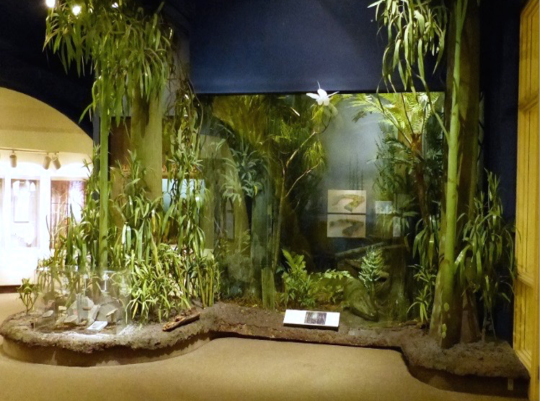
Figure 3.
In the 1940s, the 300-million-year-old Pennsylvanian age coal forest diorama was installed in a corner space of what is now part of the Benedum Hall of Geology (Fig. 3). Because coal converted to coke is a vital ingredient in steel production, this three-dimensional depiction of the conditions under which Pittsburgh’s economically important coal deposits formed was (and remains) an important public asset.

Figure 4.
In 1965, as part of an overall plan to bring more of the natural history museum’s fossil collection to the public, Paleozoic Hall opened with funding from the Richard King Mellon Foundation¹⁰. This exhibition featured nine dioramas that recreate the ancient environments through 290 million years of Earth history. Sadly, only one of the nine units remains on display, the diorama depicting the Pennsylvanian age marine seaway (Fig. 4), in the Benedum Hall of Geology.
Since the Benedum Hall of Geology opened to the public in 1988 the exhibition has featured an economic geology component with displays explaining differences between coal ranks Lignite coal to anthracite coal, and a variety of Pennsylvania’s crude oils and lubricants processed from the historic well Edwin Drake drilled in Titusville in 1859 (Fig. 1 )¹¹.

Figure 5.
Today, the Hall’s “strata wall,” a towering depiction of some of the rock layers found thousands of feet below western Pennsylvania, is in my opinion, an under-utilized display in terms of conveying information about fossil fuels. Although the wall is not currently documented with any geologic information, minor changes might allow visitors to use the lens of rock strata to better understand historical events such as the Drake Well, and economically important geologic reservoirs such as the Marcellus Shale (the second largest gas deposit in the United States), the natural gas storage reservoir of the Oriskany Sandstone, and the gas and liquid condensate (ethane) extracted from the Utica Formation (Ordovician Age) for making plastic products at the Shell Cracker Plant in Beaver County, PA (Fig. 5).

Figure 6.
Elsewhere in the museum, visitors can learn more about the topic of fossil fuels at several other locations. At the Holzmaden fossil exhibit in Dinosaurs in Their Time, there is a large fossil crinoid preserved in a dark gray limestone of Jurassic age, that represents a reservoir of crude oil in Germany (Fig. 6). At the mini diorama of the La Brea tar pits, oil seeps from natural fractures from an approximately six-million-year-old rock of Miocene age, to the unconsolidated surface sediment in what is now part of the City of Los Angeles (Fig. 7).
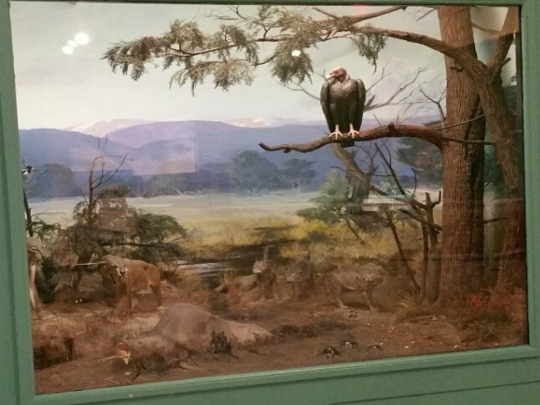
Figure 7.
Looking for Fossil Fuel Evidence in Art
In 2018, I reviewed 58 landscape paintings and the John White Alexander wall murals on the first and second floors of the Grand Staircase within Carnegie Museum of Art (CMOA) galleries to look for artistic documentation of what I interpreted to be causes for climate change based on the science. I found many examples based on the use of coal as a fossil fuel for power and coking in steel mills and the natural formation of bio-methane as portrayed in ecosystem landscapes of the industrial age of the middle 19th and early 20th century¹².
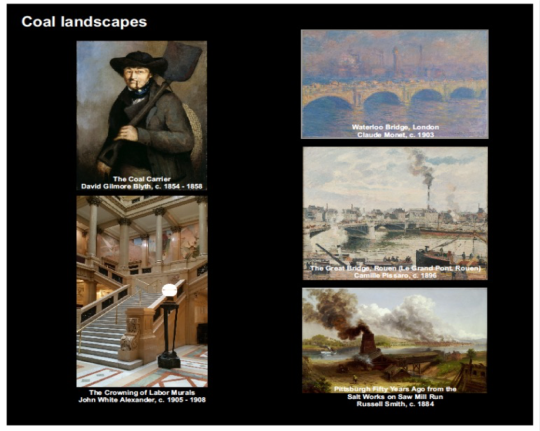
Figure 8.

Figure 9.
Searching for the CMOA landscapes paintings takes a little patience, but the visitor is rewarded by taking a new look at some of the art museum’s classic paintings (Fig. 8 and 9).
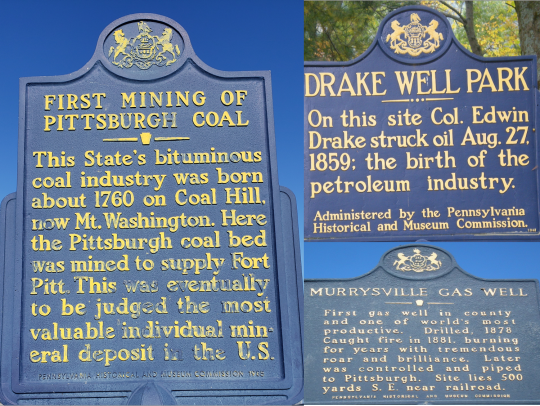
Figure 10.
Within day trip visiting distance of Carnegie Museums are historic plaques highlighting the discovery of coal on Mount Washington, natural gas in Murrysville, and oil in Titusville, Pennsylvania. (Fig. 10). At all three stops you’ll have a better understanding of the significance if you begin your investigation of fossil fuels at Carnegie Museums.
Albert D. Kollar is the Collection Manager for the Section of Invertebrate Paleontology. Suzanne Mills is the Collection Assistant and Joann Wilson is a volunteer Section of Invertebrate Paleontology.
References
1. Kollar, A.D. 2020. CMP Travel Program and Section of Invertebrate Paleontology promotes the 125th Anniversary of the Carnegie Library of Pittsburgh with an outdoor walking tour. https://carnegiemnh.org/125th-anniversary-carnegie-library-of-pittsburgh-outdoor-walking-tour/
2. Personal communications Anthony J. Young, Vice President (FP&O) Carnegie Museums of Pittsburgh.
3. Brezinski, D. K. and C K. Brezinski. 2014. Geology of Pennsylvania’s Coal. PAlS Publication Number 18.
4. Geology of the Marcellus Shale. 2011. Brezinski, D.K., D. A. Billman, J.A. Harper, and A.D. Kollar. PAlS Publication 11.
5. https://www.bloomberg.com/news/articles/2021-05-03/coal-consumption-in-the-u-s-declines-as-natural-gas-solar-wind-energy-rise
6. United States Energy Agency (EIA) 2019.
7. Bill Gates. 2021. How to Avoid A Climate Disaster.
8. Kollar et al. 2020. Carnegie Institute Extension Connemara Marble: Cross-Atlantic Connections Between Western Ireland and Gilded Age Architecture in Pittsburgh, Pennsylvania. ACM, 86, 207-253.
9. Dawson, M. R. 1988. Benedum Hall of Geology. Carnegie Magazine, 12-18.
10. Eller, E. R. 1965. Paleozoic Hall. Carnegie Magazine, 255-338.
11. Harper and Dawson 1992. Benedum Hall-A Celebration of Geology. Pennsylvania Geology, 23, 12-15.
12. Kollar et al. 2018. Geology of the Landscape Paintings at the Carnegie Museum of Art, a Reflection of the “Anthropocene” 1860-2017. Geological Society of America, Abstracts with Programs, v. 49, 243.
33 notes
·
View notes
Text

I thought these lilacs were dead. Leaves turned black and fell off, leaving nothing but bare sticks and branches behind. Now they're growing new leaves and blooming again!
#second blooming#lilacs#October blooms#08October2023#pennsylvania#southeastern PA#southern York County PA#purple flowers
1 note
·
View note